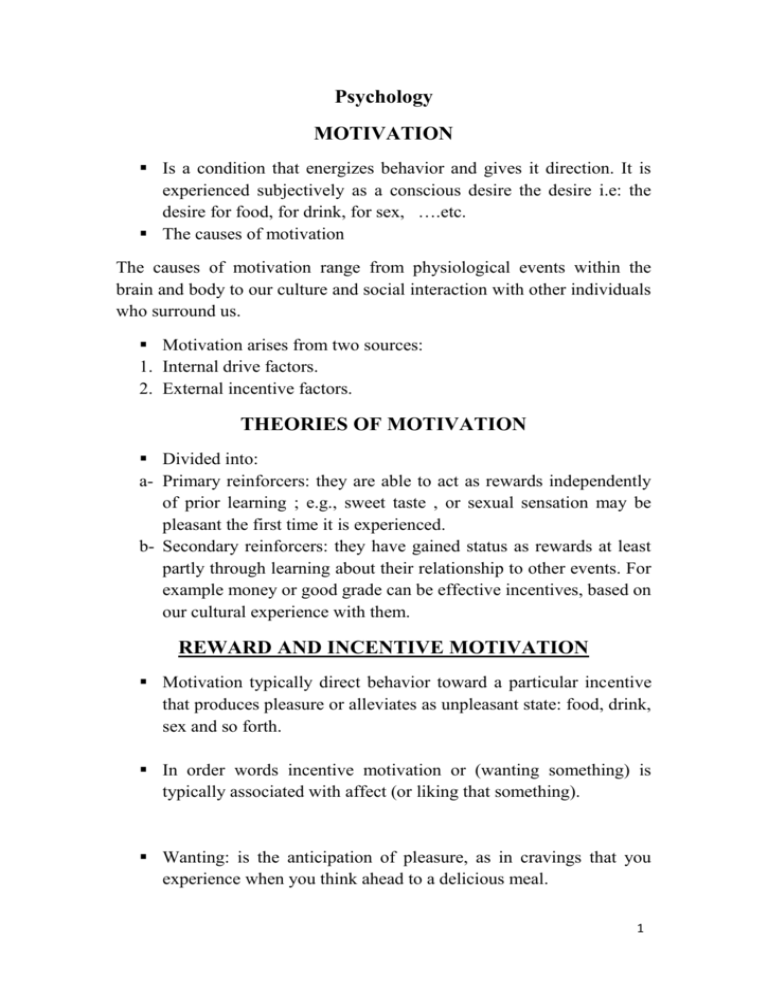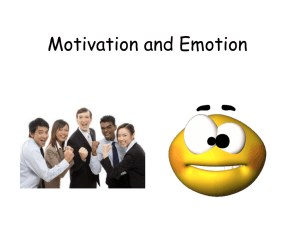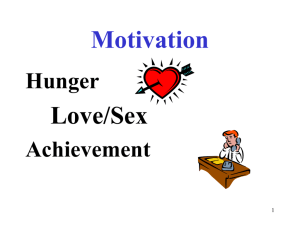Psychology MOTIVATION
advertisement

Psychology MOTIVATION Is a condition that energizes behavior and gives it direction. It is experienced subjectively as a conscious desire the desire i.e: the desire for food, for drink, for sex, ….etc. The causes of motivation The causes of motivation range from physiological events within the brain and body to our culture and social interaction with other individuals who surround us. Motivation arises from two sources: 1. Internal drive factors. 2. External incentive factors. THEORIES OF MOTIVATION Divided into: a- Primary reinforcers: they are able to act as rewards independently of prior learning ; e.g., sweet taste , or sexual sensation may be pleasant the first time it is experienced. b- Secondary reinforcers: they have gained status as rewards at least partly through learning about their relationship to other events. For example money or good grade can be effective incentives, based on our cultural experience with them. REWARD AND INCENTIVE MOTIVATION Motivation typically direct behavior toward a particular incentive that produces pleasure or alleviates as unpleasant state: food, drink, sex and so forth. In order words incentive motivation or (wanting something) is typically associated with affect (or liking that something). Wanting: is the anticipation of pleasure, as in cravings that you experience when you think ahead to a delicious meal. 1 Liking : is the pleasure that you experience in the moment you begin to eat that meal. Liking something in the past usually contributes to wanting it in future. Wanting, in particular, appears to have evolved as away for the brain to guide action in the future by keeping track of the good or bad consequences of past action. There is evidence that the brain may have a neural common currency for rewards. It is seven possible that all rewards are direct precisely because they activate the same brain systems This neural currency appears to be related to the level of activity within the brain's dopamine system. The brain's dopamine system is activated by many kinds of natural rewards, or primary re-inforcers. The same neurons are also activated by many drugs that humans and animals find rewarding, such as cocaine, amphetamine, and heroin… Many addictive drugs change the brain's dopamine system, making these neurons hyperactive or sensitized. HOMEOSTASIS AND DRIVES Homeostasis is the preservation of a constant internal state. Drive factors tend to promote homeostasis. Homeostasis involves several component: 1. A goal value or set point for the ideal internal state 2. A sensory signal that measures the actual internal state. 2 3. A comparison between the goal value and the sensory signal 4. A response that brings the actual internal state closer to the goal value. TEMPERATUYRE The regulated variable is the temperature of the blood. Sensors are located in various parts of the body including the hypothalamus. Adjustments are either automatic physiological response (shivering) or voluntary behavioral ones (putting on a sweater). THIRST There are two regulated variable : intracellular fluid and extracellular fluid. Loss of intracellular fluid is detected by osmotic sensors (neurons in the hypothalamus that respond to dehydration). Loss of extracellular fluid is detected by pressure sensors (neurons in the major veins and organs that respond to a drop in pressure) . Intracellular and extracellular signals act together to produce thirst. HUNGER Hunger has evolved to allow us to select an array of nutrients. Humans have innate taste preferences, such as for sweetness and innate aversions such as for bitterness that guide our choice of foods. We may develop a wide variety of learned preferences and aversions. 3 Homeostatic hunger signals, which arise when the body is low in calorie- containing fuels such as glucose, produce appetite partly causing the individual to perceive food incentives as more attractive and pleasant. Hunger is largely controlled by homeostatic deficit and satiety signals. Certain neurons in the brain, specially in the brain stem and hypothalamus, detect shortages in glucose and trigger hunger Other nutrient detectors, specially in the liver, detect increasing energy stores and trigger satiety. A satiety signal, in the form of the hormone cholecystokinin is released from the intestines to help stop hunger and eating Two region of the brain are critical to hunger : the lateral hypothalamus and the ventromedial hypothalamus. Destruction of the lateral hypothalamus leads to understanding, while destruction of the ventromedical hypothalamus leads to overeating. Although these regions were originally thought to be centers for hunger and satiety hunger and satiety, hunger is not destroyed by any lesion. on the homeostatic set point of body Another interpretation of these effect is that the two regions of the hypothalamus exert reciprocal effects on the homeostatic set point of body Damage to the lateral hypo. Many lower the set point and damage to the ventromedical hypo., may raise the set point. Diet drugs alter appetite may work partly affecting neurons in the region of the hypothalamus 4 OBESITY People become obese primarily because: 1. They are genetically predisposed to be overweight. 2. They overeat (for psychological reasons). The influence of genes is mediated by their effect on the fat cells, metabolic rate and set points. People eat more when: they break a diet, are emotionally aroused, and are more responsive to external hunger cues than normal weight individuals. In treating obesity extreme dieting is ineffective: leads to subsequent overeating and lowers metabolic rate. The best way is permanent eating habits with exercise ANOREXIA NERVOSA AND BULIMIA NERVOSA Anorexia nervosa an eating disorder characterized by extreme, self imposed weight loss. Bulimia is characterized by recurrent episodes of binge eating, followed by attempts to purge the excess by means of vomiting and laxatives. Possible causes of these disorders include: 1- Personality factors such as low self esteem. 2- Social factors such as cultural messages that objectify the female body. 3- Biological factors such as low serotonin levels. GENDER AND SEXUALITY Sexual desire is a powerful motivation. It differs from survival motives like hunger and thirst in many things 5 1- Sex is asocial motive, it typically involves another person, where as the survival motives concerns only the individual. 2- Sex does not involve a internal deficit that needs to be regulated and remedied for the organism to survive. Consequently, social motives do not lend themselves to a homeostatic analysis. Although we begin to mature sexually at puberty, the basis of our sexual identity is established in the womb (uterus). So we should differentiate between adult sexuality and early sexual development. We should also make a distinction between the biological environmental determination of sexual behavior. Gender identity : means males come to think of themselves as males and females as females. Early sexual development - Prenatal hormones contribute to sexual development. If the embryonic sexual glands produce enough androgen hormone the embryo will have a male pattern of genitals and brain denelopment. - For nonhumans , prenatal hormones appear to be powerful determinants of adults sexual behavior. Sexual behavior For humans, prenatal hormones appear to be much less important although they may still play a role in later sexual behavior. In cases in which the hormonal exposure of the embryo is typical of one sex but the social role and gender after birth is more typical of the other sex (due to hormone imbalance, prenatal drugs, or a postnatal accident), the individual's development seems to correspond most closely to the postnatal social gender. Adult sexuality The female hormones (estrogen and progesterone) and male hormones (androgens) are responsible for the changes in the body that 6 occur at puberty , but they play a limited role in human sexual arousal. In contrast, in animals there is substantial hormonal control over sex. Early social experience with parents and peers have a large influence on adult sexuality in primates and humans. Although Western society has become increasingly flexible regarding female and male sex roles, men and women may still differ in their attitudes to ward sex and relationships. Sexual orientation Recent studies have bolstered the claim that biological, genetic, hormonal, or neural factors may partly determine whether an individual will be heterosexual or homosexual but the evidence is not conclusive. It is also unknown whether biological factors may influence sexual orientation directly or whether they instead contribute to other traits, such as gender conformity , that indirectly influence the development of sexual orientation. 7








